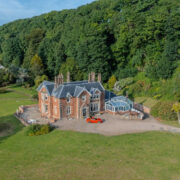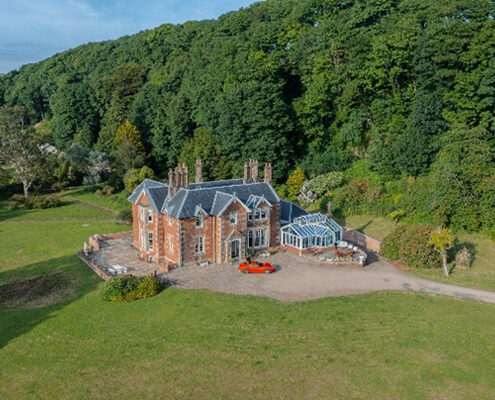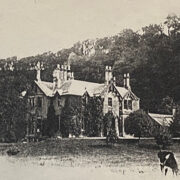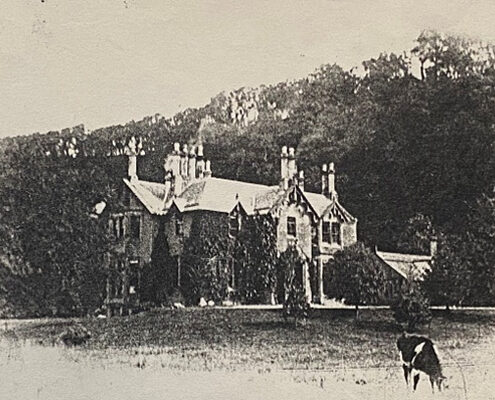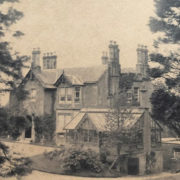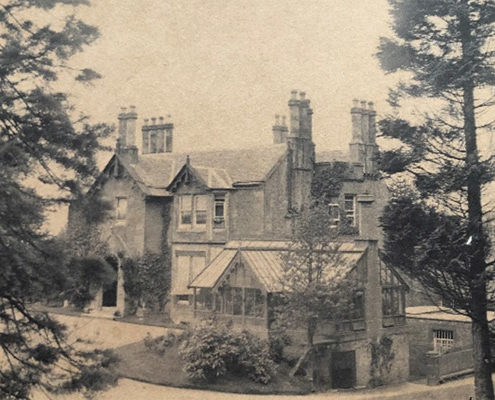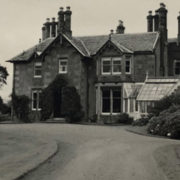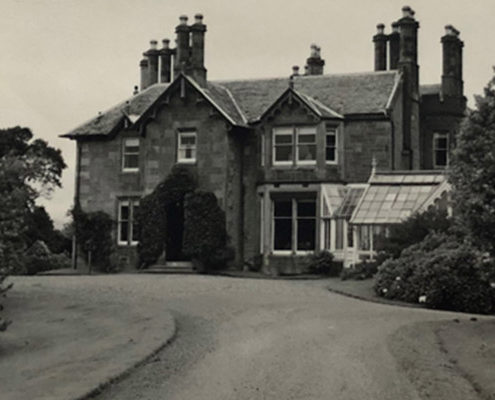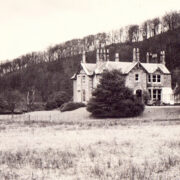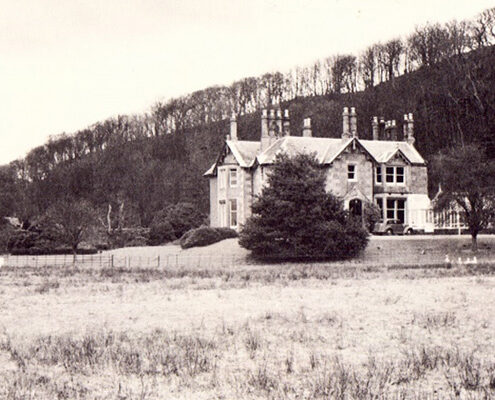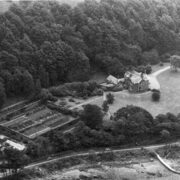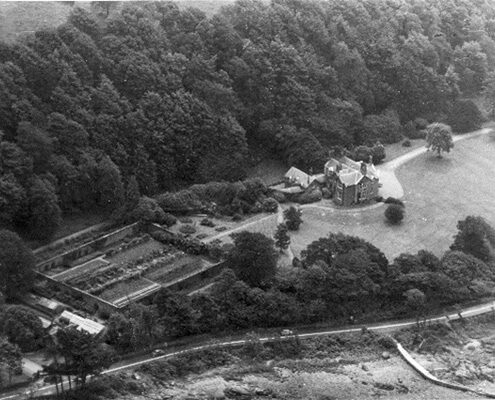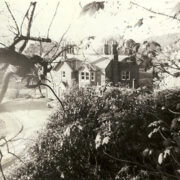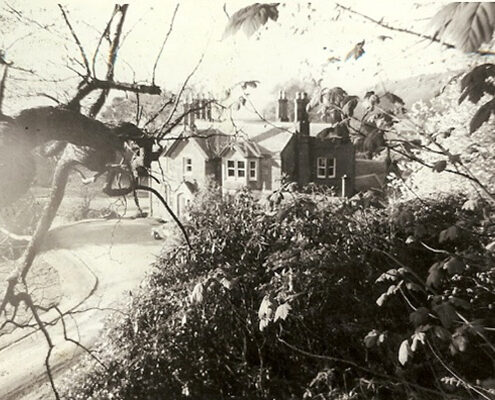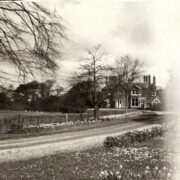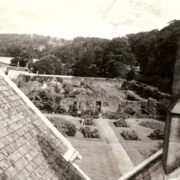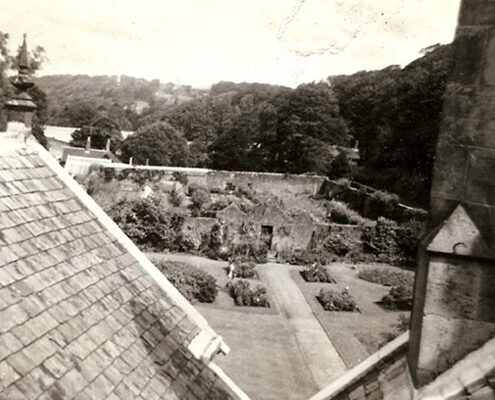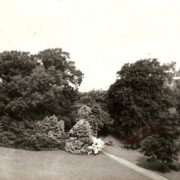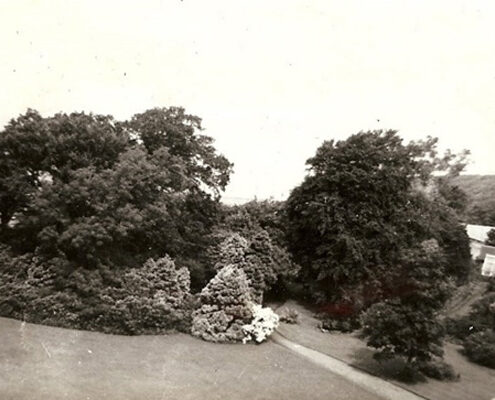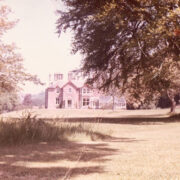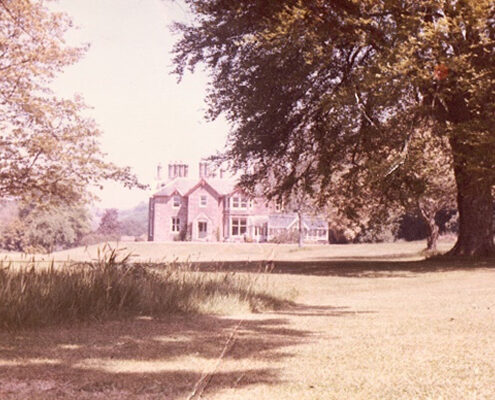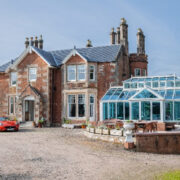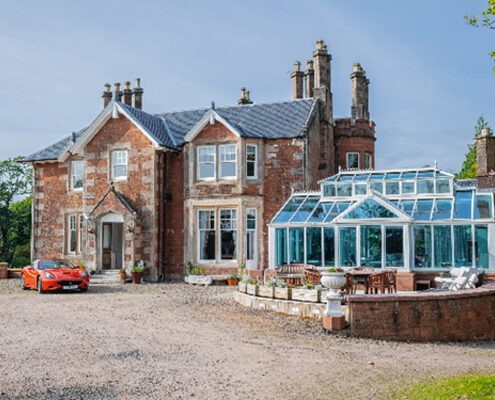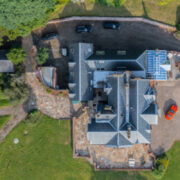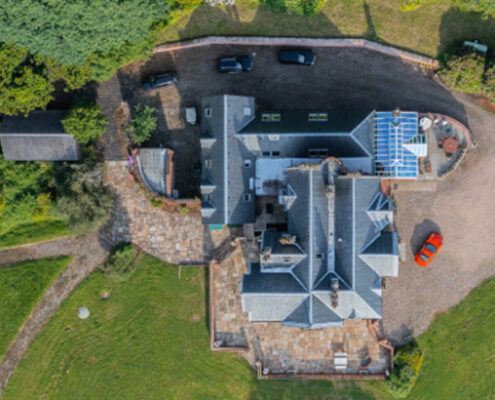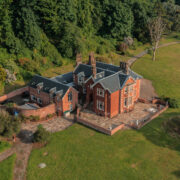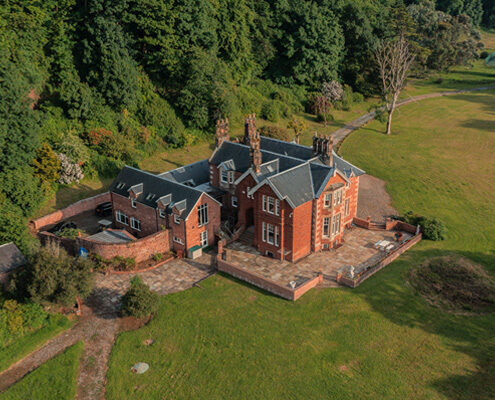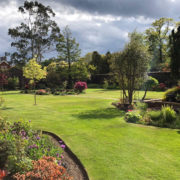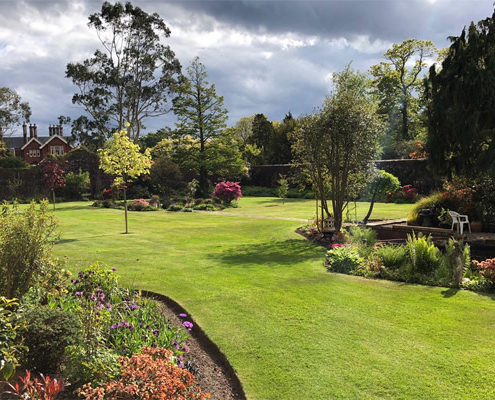Shore Road, Skelmorlie
Photos: 1. Ashcraig 2021 (Corum Sales Brochure). 2. Ashcraig circa 1860s by Robert MacKenzie – his father Ian was gardener 1861-1867. 3. Ashcraig circa 1920 (Mrs J Yeomans) 4. Ashcraig 1952 Sales Brochure (Mrs J Yeomans) 5. Ashcraig circa 1950s (Mrs J Yeomans). 6. Ariel view of Ashcraig and market garden 1950s. (H Maclaren) 7. Ashcraig from the waterfall 1960s. (H Maclaren). 8. Ashcraig Daffodils 1960s (H Maclaren) 9. Ashcraig 1960s from roof looking northward to wall garden (H Maclaren). 10. Also from Ashcraig roof – looking northwest towards north lodge and greenhouses (H Maclaren). 11. Ashcraig from South 1970s (Mrs J Yeomans). 12. – 14. Ashcraig 2021 (Corum Sales Brochure). 15. Ashcraig wall garden 2022 (N Dunsmore)
Video excerpt from The Beechgrove Garden June 2000 showing the secret garden
| Owners | Dates | Alterations |
|---|---|---|
| George R Boyle, 4th Earl of Glasgow | 1775 – 1823 | 1775: The Earls of Glasgow become owners of the land through marriage. |
| Mr & Mrs Andrew D Campbell | 1823 – 1855 | 1823: Land Purchased c.1825: Cottage built followed by main house. Architect: Unknown. Gardens laid out by Henry Watson. |
| Misses Helen & Margaret Stewart | 1855 – 1917 | 1873: Alterations incl. extension to North. Architect : J Honeyman* 1876: Turret added 1883/4: New Conservatory. |
| W G Stewart & Lt. Col. Kennedy | 1917 – 1918 | |
| Mr & Mrs Robert D French | 1918 – 1928 | |
| Mr & Mrs Richard G Allan | 1928 – 1952 | |
| Mr & Mrs Ian Maclaren | 1952 – 1975 | |
| Mr & Mrs Richard M Yeomans | 1975 – 2004 | 1979: Stables converted to “Coach House”. |
| Current owners | 2004 – present | 2004 – 11: Main House extended to E to create new kitchen. a family area with garages below, replacement conservatory and conversion of the “coach house” to gym and spa. |
* Source: Dictionary of Scottish Architects design report. www.scottisharchitects.org.uk/
About the house:
The story of Ashcraig starts in 1823, when a feu contract was signed between George (Rosse Boyle), (4th) Earl of Glasgow and Andrew Donaldson Campbell, Merchant (Glasgow) for two plots of land:
- the first of 7 acres, 2 roods and 2 falls running from the Meigle southwards, bounded on the west by the sea and the east by the bank of trees.
- the second of 3 acres and 17 falls, to the south of the first, again bounded by the sea on the west, the trees on the east and what is now Auchengarth farm to the south. [1]
When the contract was first signed, the feu duty was set in ‘Bolls’ of oatmeal per annum (See Note below). The lease was based on an initial term of 76 years, with rent of 10 bolls and 3.75 lippies of oatmeal per annum for the first 19 years, increasing to 15 bolls, 1 peck and 1.75 lippies for the subsequent 19 years and again by 50% of the original rate for each of the remaining two periods. [1][2]
Author’s note: The basic unit of dry capacity was the boll (from the word ‘bowl’). A quarter of a boll was a firlot, a quarter of this was a peck and a quarter of a peck was a forpet or lippie. Thus, there were 64 forpets or lippies in a boll. Lippies, pecks, firlots and bolls varied depending on what was being measured. An 1863 trade dictionary defined one boll of oatmeal as 140lbs. [2]
The feu contract required a house to be built to the value of not less than £500, and for it to be inhabited by Whitsun 1826. It’s understood that Ashcraig Cottage, situated to the north of the main house and wall garden, nestling at the foot of the cliffside, was built first. This became the home of the landscape gardener and factor, Henry Watson. Henry came to lay out the gardens and walks of Ashcraig, which remain in much the same layout to this day. [1][3]
Author’s note: Walter Smart in his book on Skelmorlie suggested that Henry Watson came to Ashcraig in 1820 but it is far more likely to have been 1823/24 after the feu contract was signed. [14]
The architect and builders of Ashcraig are not known. The main house has a slate roof and is built of locally quarried red sandstone. The title deeds allowed A.D. Campbell ‘the full and free use of the quarry on the lands of Thirdpart for making such buildings as he may erect…’. [1][3]
The house was built over three floors with the ground floor as a basement incorporating a kitchen, wine cellar, larders, staff hall and staff bedrooms. The earth was then mounded up to form the drive and lawns leaving the windows in the basement half above and half below ground. The ground fell away to the east side of the house so that the staff entrance, wash house, laundry and courtyard were at ground level. The service pipes ran round the outside of the basement in a dry moat.[3]
Up until the late 1990’s, water was privately supplied from a spring in the middle of the field directly above the house and collected into a holding tank at the top of the cliff. Due to the 100ft cliff fall the water pressure was always good, but once the springs began to fail, the house was connected to the Skelmorlie water main. [3]
The house faces south. Through the main doorway and porch, there is a hall which runs from the front to the back, with a French window looking out onto the garden to the north. Off the hall to the seaward side, there is a study/morning room and a drawing room. The dining room and main staircase are on the other side of the hallway Originally, off the dining room was the butler’s pantry (including dumb waiter down to the basement), the silver safe and a flower room. [3]
The main staircase is panelled in oak and has a large leaded window halfway up the stairs. There were originally five bedrooms and above the centre landing, was a cupula roof light.[3]
Adjoining the main building were the stables, above which were servant’s bedrooms rooms and originally the hayloft. Across the courtyard was a harness/tack room. [3]
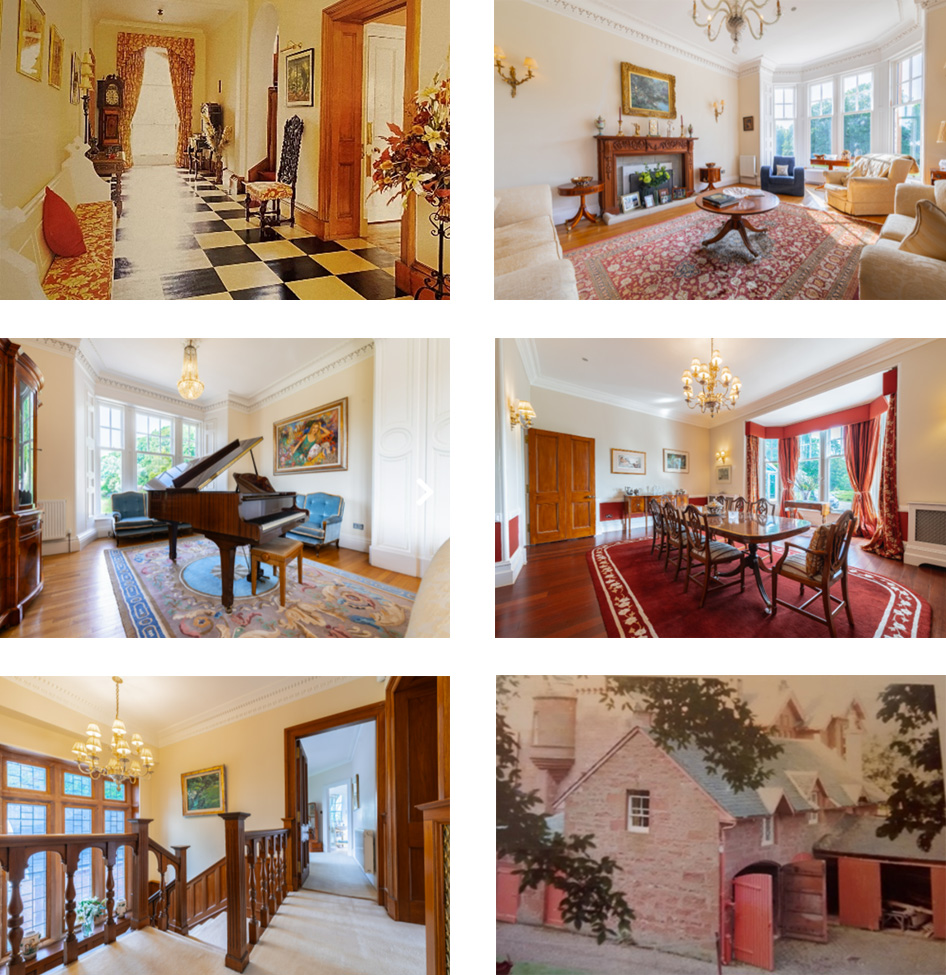
| Photos: 1. Main hallway – Savilles’ sales brochure 2003. 2. – 5. Drawing room south, drawing room north, dining room and upper staircase – Corum’s sales brochure 2021. 6. Original stables with rooms above – Source: J Yeomans. |
Turning to the owners ….
1823 – 1855: Andrew Donaldson & Mrs (Janet) Maria Campbell

Friends of Glasgow Necropolis, Grave Matters, Issue 5, Autumn 2018 [4]
Author’s note: Marion Muirhead was a first cousin of James Watt, the famous inventor, making A D Campbell a first cousin once removed. [3][4]
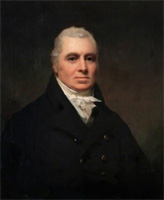
Robert Muirheid of Croyleckie by Henry Raeburn. Huntarian Art Museum, Glasgow.
Like his father, A D Campbell was also a merchant in Glasgow, but rather than in the saddlery business, he was in the timber trade with his uncle Robert Muirheid/Muirhead of Croyleckie (1748-1828). The business had a yard in Grahamston, a Glasgow village eventually demolished to provide the site of Glasgow Central Station [5][6]
Note: Robert Muirheid was married to Lilias Dunlop (1753-1837), aunt of Janet Dunlop, who A D Campbell later married, making Janet and Andrew first cousins as well as spouses. [6][7][8][9] It appears that Robert Muirheid played a significant role in A D Campbell’s life. Not only was he Andrew’s uncle, he was a witness at his baptism, his first employer and when Andrew was only 25, Robert invited him to become a business partner. Robert is also believed to have built and lived at Warren Park in Largs, just 5 miles from Andrew’s future home.[3][5]

Househill, near Paisley.
A D Campbell married Janet Marie Dunlop (known as Marie) in February 1817, when he was 40 and she was of similar age. From her last will and testament, we know that Janet was a co-heiress of the Househill estate near Paisley and one of the four daughters (Elizabeth, Harriet, Janet/Marie & Frances) of Colonel James Dunlop (1724-1821), 2nd of Househill and Elizabeth Buchanan (d 1820). [3][6][7][8][9] Prior to 1841 and the first census, there are few public records, so little is known about the Campbells early life at Ashcraig. However, we have found the following references which provide some insight into Andrew’s business and general interests. There have been suggestions that A D Campbell as well as a merchant was also a Jamaican/West Indian sugar planter. This idea appears to have emanated from William Watson’s writing about ‘Life in the Confederate Army (1887)’. However, historian James Brennen, having examined Campbell’s life, can see no evidence of this and indeed believes he may never have even visited Jamaica. [5] It could be argued that whether Andrew was a Jamaican Sugar Planter or not is down to semantics as A D Campbell did hold a mortgage over a Jamaican plantation, Florence Hall, owned by a Charles Campbell (not believed to be a relative) and following the Slave Emancipation Act in 1833, which gave (time served) slaves their freedom, it was A D Campbell rather than Charles Campbell who drew the compensation money on the freed slaves. At that time the mortgage on Florence Hall amounted to £3883, worth just under £0.5m in today’s money and there were 190 slaves on the plantation. [5][11][12] A D Campbell also appears to have been an investor, to the tune of £2,500, in the Glasgow, Paisley and Greenock Railway (GP&GR) (See Note below). The company was set up in 1837 and the contract for the first 7 miles of railway was awarded in 1839. Records show A D Campbell speaking at a directors meeting in December 1838. [5][13]
Authors Note: The Glasgow, Paisley and Greenock Railway was an early Scottish railway, opened in 1841, providing train services between Glasgow and Greenock. At the time the river Clyde was not accessible to sea-going ships, and the intention was to compete with river boats that brought goods to and from the city. In fact, passenger traffic proved surprisingly buoyant, and connecting steamer services to island resorts in the Firth of Clyde provided a great source of business. [13]
In other articles we learn of Andrew’s lifelong friendship with a Littleton Dennis Treackle, a Maryland merchant, who modelled the façade of his own house at St Anne’s in Maryland following a visit to Chatelherault, the Duke of Hamilton’s hunting lodge, with Andrew. Later, Andrew is understood to have made a reciprocal visit to Maryland and in his will Andrew leaves £50 to Mrs Eliza Quembly of York, Pennsylvania, ‘the daughter of my much esteemed friend Mrs Treackle, in the event of her death £50 to her son’. [5][8] At the time of the first general census in 1841, Andrew and Maria Campbell were at Ashcraig, both recorded as 60 rather than 64 years of age. They had one visitor staying with them, a Robert McReddie, merchant, aged 20. (Note from author – this could well be a great nephew). [10] They also had five live-in servants, including a Margaret Watson, possibly the eldest daughter of Henry Watson. Henry as factor and gardener was living at Ashcraig cottage, with his second wife and four of his children including William Watson, aged 15, Maria aged 12, Robert aged 5 and Richard aged 3. [10] Again, at the time of the 1851 census we find both Andrew and Maria Campbell at Ashcraig, but this time they are recorded as both being aged 50 when they were in fact 73 or 74 – vanity or a genuine mistake? There are no visitors at the time but there are four live-in servants including Elizabeth Watson (Henry’s second daughter), Lady’s maid, aged 23. [10] Andrew Donaldson Campbell died in July 1854 and Maria in 1855.[3] As the couple appear to have had no children, Andrew’s money was left to various relatives, acquaintances, and servants. From Walter Smart’s book on Skelmorlie, we learn that AD Campbell’s heirs owned Skelmorlie Bank, but it’s not been possible to verify this or discover the family link.[14] Maria’s Will also contained bequests to family members, friends and servants (in the case of the latter, Henry Watson’s family received almost £100 or £10,000 in today’s money), but her fortune passed to her sisters, the co-heiresses of her father’s estate and in due course to the next-in-line male family member. [8] Ashcraig was sold at auction on 23 May 1855 at the Royal Exchange Sales Rooms in Glasgow. John Morrison was the auctioneer, the upset price was £3,000 and after numerous bids, the estate was sold for £4,020. The purchaser was Helen Love Stewart of ‘Clydebank’, Greenock, aged 29. [1][3]
1855 – 1917: Misses Helen and Margaret Stewart
Helen Love Stewart was born 7th February 1826, the first child of James Stewart (1785-1837), and Joanna (Shaw) Stewart who had married the year before in the Old West Kirk, Ninian Hill, Greenock. Her father sometimes referred to as merchant and sometimes shipowner founded a company called J & W Stewart which traded between Greenock and New Foundland. From a plaque erected in Old St Ninians church by Helen in 1886, we know that ‘James Stewart lived at Clydebank House, on the Esplanade. He was Provost for only one day, having been elected when he was lying ill with fever. He died the following day.’ [15][16]
James & Joanna Stewart went on to have a further six children: James (1827 – 1895), William (1829 – 1838), Mary (1828 -1875), John (1834 – 1842), Margaret (1835-1916) and Joanna (1837-1839). [16][17]
It’s perhaps worth mentioning that James Stewart (the eldest son and brother of Helen and Margaret) took over and ran his father’s business J & W Stewart. He bought the lands of Garvocks (Renfrewshire) and subsequently Routenburn and Quarter. He was liberal MP for Greenock (1878 – 1884) and succeeded to Blackhouse (Manor Park) on the death of his uncle, thereby becoming a close physical neighbour to his sisters. [3]
Although, it was Helen who initially purchased Ashcraig, Margaret her younger sister by 9 years moved in from the outset and in 1872 bought a half share of the estate from Helen.[1]
The Misses Stewart never married, instead they focussed their time and energy on developing the estate. In 1871, Helen acquired an additional 19.75 acres from the Earl of Glasgow (3 x fields at the top of the cliff) which took the estate to 52 acres in total. [1]
Helen’s transcribed notes below show how she and her sister developed the house and gardens, during their lives. [1][3]
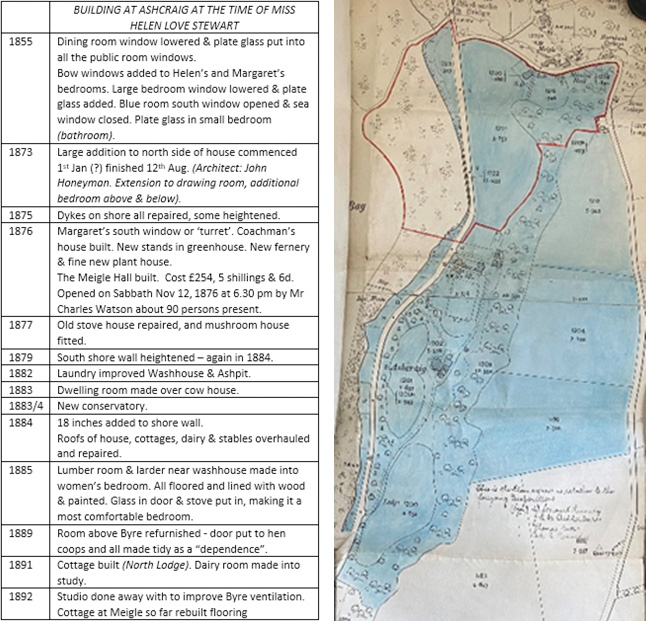
Photos: 1 Helen’s notes covering maintenance & enhancements of Ashcraig- Mrs J Yeomans 2. Deeds showing the temporary split of the estate (blue) following Margaret’s death. The estate at the time stretched from the Meigle in the north to Auchengarth in the south and from the beach on the west to the Old Largs (Red) Road on the east.
![Mary (Stewart) Kennedy (sister of Helen and Margare) with her family (twins, a daughter, and a son) on the rear porch of Ashcraig. [20] The photo is estimated to be around 1880 as the ivy-covered extension was added in 1873](https://www.skelmorlievillas.co.uk/wp-content/uploads/2022/09/ashcraig-house-1880.jpg)
Mary (Stewart) Kennedy (sister of Helen and Margaret) with her family (twins, a daughter, and a son) on the rear porch of Ashcraig. [20] The photo is estimated to be around 1880 as the ivy-covered extension was added in 1873
In 1876, they built a small chapel at the Meigle for the benefit of those residing in the district. Note: This is marked on the 1912 survey as the Mission Hall, Meigle. The chapel was built of concrete and was erected as a meeting place for members of any denominations who chose to attend. The chapel still stands today but was converted to a house approximately fifty years ago. [14][18]
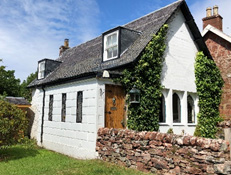
House previously concrete chapel
As well as the small chapel at the Meigle, the Misses Stewarts, together with the owners of Haylie House (Largs) and Knock Castle, were almost entirely responsible for rebuilding the Free Church (St John’s) in Largs. A leaded window of St John on the left hand-side looking towards the alter mentions the Misses Stewarts as benefactors. [3][14]
The Misses Stewart like many Victorian ladies of the time were also involved in the temperance movement. An article in the Largs and Millport in 1885 referred to the British Workman Public House (coffee shop) and Miss Margaret Stewart being the best friend it ever had. [3][19]
The same paper includes articles about the ladies attending a fashionable wedding and concert (1886), being present at Sir William Thompson’s lecture (Lord Kelvin) on the telephone (1877), an outing of 60 children from Mission Sunday School to Ashcraig where the ladies gave them books and sweets (1878) as well as reference to their interest in the Brisbane Academy and the Girls Holiday Home (believed to be Seafield home, Ardrossan). [3][19]
The Misses Stewart were at Ashcraig until their deaths: the eldest, Helen, in 1895 aged 69, her death witnessed by her niece and the younger, Margaret, in 1917 aged 82, witnessed by her nephew William Stewart Kennedy (W.S.K). [15]
![Photo 1: Lt. Col. E Kennedy [20] Photo 2: William S Kennedy [20]](../wp-content/uploads/2022/09/ashcraig-kennedys.jpg)
Photo 1: Lt. Col. E Kennedy [20] Photo 2: William S Kennedy [20]
Upon Margaret’s death, her nephew William George Stewart of 3 Palliser Road, West Kensington, London, inherited Ashcraig. It was most likely that William was one of Margaret’s eldest brother’s (James) children. [21]
What happened next is a little unclear, but ultimately Lt. Colonel Edward Douglas Kennedy (1856 -1937) paid £5,000 to Margaret Stewart’s trustees for Ashcraig in December 1917. Edward who resided at ‘The lodge, Ludlow, Salop (Shropshire)’ was the eldest son of Mary (Stewart) Kennedy, one of Helen and Margaret’s sisters (See note below). His younger brother William Stewart Kennedy or W.S.K. (1862 – 1940) received a life interest in Margaret’s will, in a bungalow he’d designed and built at the Meigle, around 1906. [3][20][21]
Author’s note: Helen and Margaret’s sister Mary married Robert Alexander Kennedy (1819 -1902) in 1849. They subsequently had children including Lt Col Edmund D Kennedy (1856 – 1937) and William Stewart Kennedy (1862 – 1940). [20]
The bungalow had a tin roof and a veranda on most sides, in imitation of dwellings in Singapore where W.S.K. is believed to have lived for a time. [3][20]
![1. The Meagle owned by W.S.K. [20] 2. The Meagle - View of Porch and Garden [20]](../wp-content/uploads/2022/09/ashcraig-tin-house.jpg)
1. The Meagle owned by W.S.K. [20]
2. The Meagle – View of Porch and Garden [20]

North Lodge Ashcraig Sales Brochure 1952 – Mrs J Yeomans.
We are told that W.S.K. was a bachelor and that he lived in Edinburgh in the winter at his house in Bedford Place and in the summer at the bungalow which he named the Meagle. W.S.K. is also understood to have had some architectural training and as well as the bungalow or tin house as it became laterally known, is believed to have designed North Lodge at Ashcraig, built in 1891. He also wrote humorous poetry, short stories, and the occasional play.[3][20]
Author’s note: The Meagle / Tin House was sold c. 1954 by the then owners of the estate. It stood until approximately 1980 when it was demolished, and a modern bungalow erected in its place. [3]
1918 – 1928 Mr & Mrs Robert Drummond French
Edward Kennedy did not hold onto Ashcraig for long and in March 1918 sold Ashcraig to Mr & Mrs Robert French for the sum of £3,600. [22]
Robert Drummond French was born in 1868 to William Innes French, a Metal Agent or Ironmaster and Rosina (Alexander) French. He married Jeanie Cleland McKendrick in 1901 when he was 33 and a Ships Clerk and she was 31. At the time Robert was living at 13 Kelvinside Terrace and Jeanie with her mother at 7 Hanover Terrace (now 14 Kingsborough Gardens), her father, an engineer had died a few years earlier. [23][24]
After their marriage, they appear to have stayed at Robert’s house for a year, thereafter we lose track of the couple until they move to Ashcraig in 1918, although there are suggestions of an address at Bothwell Street in Glasgow. [3][24]
On Robert’s marriage certificate, he gave his occupation as Ships Clerk, 17 years later when he purchased Ashcraig, he had become a shipowner and was well known in shipping circles. [3][22][23]
We’ve been unable to find out much about the French family other than there was a daughter who enjoyed painting and used the upstairs portion of the Byre as her artist studio and that there were Frenchs living at The Beeches until 1980. We do not know if the two families were related but if they were, they would be at least one generation apart. [3]
Robert French died in September 1927 at Claremont Terrace Glasgow although the death certificate cites Ashcraig, Skelmorlie as his usual address. His brother was present at the time of death. [23]
Robert’s Trustees James French C.A. and John Greig (Shipowner and brother-in-law)) then put the house on the market and Jeanie moved back to Glasgow’s West End, where she died some 15 years later in 1943. Her death was witnessed by her son-in-law James Fleming. [3] [23]
1928-1952 Mr & Mrs Richard Gilkison Allan

Allan Line Advert – www.norwayheritage.com
In 1928 Ashcraig and all its lands were purchased by Richard Gilkison Allan, aged 71 of Asgog House, Rothesay for £4,500. Prior to living in Rothesay, Richard and his wife had lived at The Cliff, Wemyss Bay. [1][3] Richard Allan was born in December 1857 to James Allan (1808-1880), shipowner and Eleanor (Gilkison) Allan. [28]
His grandfather Alexander Allan (1780 – 1854) founded the famous Allan Line in 1819 and in due course James (Richard’s father) and his four younger brothers (Hugh, Andrew, Bryce and Alexander) all worked for the family business, trading between the Clyde and Canada. James, Richard’s father, personally captained the barque “Arabian” on its maiden voyage in 1837 and on retiral from the sea, he oversaw the shore-based aspects of the business. When failing health obliged him to withdraw from active involvement in the business, he took up summer residence at Skelmorlie Bank, and died there in August 1880. Undoubtedly Richard would have visited him there and perhaps set his mind on retiring to Skelmorlie when the time came. See notes below for a brief history of the Allan Line. [26][27]
Author’s note: The Allan Shipping Line was started in 1819, by Captain Alexander Allan of Salcoats, Ayrshire, trading and transporting between Scotland and Montreal, a route which quickly became synonymous with the company. By the 1830s the company had offices in Glasgow, Liverpool and Montreal.
All five of Captain Allan’s sons (James, Hugh, Andrew, Bryce and Alexander) were actively involved with the business, but it was his second son, Sir Hugh Allan, who spearheaded the second generation. In 1854, Hugh launched the Montreal Ocean Steamship Company as part of the Allan Line, and two years later ousted Samuel Cunard to take control of the Royal Mail contract between Britain and North America. By the 1880s, the Allan Line was the world’s largest privately owned shipping concern.
In 1891, the company took over the State Line (founded 1872) and was often referred to as the Allan & State Line. In 1897, Andrew Allan amalgamated the various branches of the Allan shipping empire under one company, Allan Line Steamship Company Ltd., of Glasgow. The company by then had added offices in Boston and London.
In 1917, under Sir Montagu Allan, who represented the third generation of the Allan family, the company was purchased by Canadian Pacific Steamships and by the following year the Allan name had disappeared from commercial shipping.[26]
Richard Allan was one of at least eight children (4 boys and 4 girls) but we know little about his early life other than what we can glean from the censuses. In 1881 (census), Richard aged 23, was living in the 18 roomed, 2 Park Terrace in Glasgow, as head of the household and an occupation of shipowner. Two years later in late 1883, Richard then 25 married Agnes Murdoch, aged 22. Agnes at the time was living with her mother and father at 7 Park Street East (now 7 Park Circus Place) just a 4-minute walk away from Richard’s home. [27][28][29] It is likely that Richard and Agnes, post marriage, either owned or rented several houses, as at each of the subsequent censuses we see a different address. In 1891, Richard is on his own as Head of household at Treesbank House, a large 17th century country house, near Kilmarnock. Agnes is not with him but he has two visitors; a naval Architect and a Sculptor. There were 5 live-in servants. [29] By 1901 the family Richard, Agnes and a 2-year-old son, also named Richard are living at 3 Park Circus in Glasgow. In 1911, the family with Richard as head are living in Dundonald, near Troon. Before buying and moving to Ashcraig we also know that the family previously stayed at the Cliff Wemyss Bay and Ascog House, Isle of Rothesay. [1][3]29] R G Allan appears to have been quite a character! [3][25] Stories talk about him walking along the Largs (Shore) Road beside Ashcraig for his evening stroll and when he heard a vehicle approaching, he would hold out his walking stick at arms-length to keep the vehicle at bay. They would then have to follow him at a snail’s pace. [3][30] We also know that Richard was a keen yachtsman and that he moored his yacht ‘Norena’ in the bay off the slipway. His nephew recounted that one day, the German Kaiser asked R.G. Allan to helm his yacht in a race. The Kaiser sent his equerry with word that he (the Kaiser) would arrive at the yacht at 09:00 hrs. R. G Allan sent word back with the same equerry that it would not be convenient for the Kaiser to come until 10:00 hrs – apparently the Kaiser reluctantly agreed, proof that Richard was an excellent helmsman, as the Kaiser was not known to compromise. [3][30] Richard only lived at Ashcraig for three years before his death in 1931, aged 73. Mrs Allan stayed on at Ashcraig for a further 21 years until her death in May 1952, aged 91. Their son, Richard, registered both deaths and was living in Moreton-in-Marsh when his mother died. [28] Mrs Allan was reportedly a very kind-hearted and generous lady and although we know nothing of her hobbies and interests, we have found the following classified advert in the Scotsman where she has opened the grounds, presumably to benefit a charitable cause. [3]
| Saturday May 12. Ayrshire- Ashcraig, Skelmorlie, “Admission 6d. Tea 1s, Golf, Croquet, etc. 3d (Mrs. Allan). Source: Scotsman, Saturday May 12, 1934 – page 11. [25] |
We were also told that after her death, all the staff were given the choice of receiving a year’s wages and departing immediately or staying on for the year. At the time Mrs Ganley, who in due course owned the Queens Hotel in Largs, was the housekeeper, her husband the chauffeur (he is understood to have been given the Rolls Royce) and her mother had been cook to the family earlier. [3][30] When R.G. Allan was still alive, we believe there were seven people employed in the house and a further seven in the grounds (including 3 on the yacht moored off the slipway). [30] R.G. Allan’s son, also Richard, put Ashcraig up for auction with Jackson-Stops & Staff with the sale scheduled for September 10,1952 in the Station Hotel, Ayr. [31] There were eight lots which were to be sold as a whole if possible and if not to be offered individually:
- Ashcraig House, South Lodge and Policies 15.8 Vacant Possession except part let at £4 p.a.
- North Lodge and Market Garden 2.0 Vacant Possession
- Ashcraig Cottage and Small Cottage 0.9 Vacant possession of Chauffeurs cottage
- Meigle Bungalow and Garden 0.4 Let at £32 15s 0d p.a.
- Postman’s Bungalow & Garden 0.7 Let at £10 p.a.
- Valuable Roadside Field 6.5 Let at £12 per annum.
- Three productive fields 19.7 Let at £35 per annum
- Valuable Woodland 6.0 Vacant Possession
Total Area 52.1 Acres [31] On the day, the whole estate was bought by Mr Ian Garnet MacLaren and Annette Mary (Birtwistle) MacLaren. [1]
1952 – 1975 Mr & Mrs Ian Maclaren Ian Maclaren was born in Troon in 1915 to Norman Henry William Maclaren and Mary Margaret (Garnett) Maclaren.[32][33] It is worth highlighting that Ian’s father Norman, was brought up from the age of 12, in Skelmorlie at Duncliffe (Miramar). Following his mother’s death in 1900, Norman inherited Duncliffe but sold it just before he married Ian’s mother and moved to Troon. Ties with Skelmorlie must have been strong because Ian’s parents had considered purchasing Ashcraig when it came up for sale in 1928, but they decided it wasn’t the right house for them. Clearly Ian and Annette thought otherwise when it came their time to view it! [36] Ian was brought up in West Kilbride while his father was a Professor at Glasgow University. After an engineering apprenticeship, he joined the family firm of Robert Maclaren & company which manufactured thermostats in Glasgow. [32][33][34] Just prior to the WW2 war, he joined the Territorial Army. He was mobilised in 1939 and transferred to the RAF in 1941 where he flew Blenheim light bombers and received a DFC (Distinguished Flying Cross) for action in Tunisia. By the end of the war, he had risen to the rank of wing commander. [34] After demobilisation, he returned to the family company in Glasgow, eventually becoming managing director. [34] In 1947 when he was 32, he married Annette Mary Birtwistle aged 26, daughter of James Astley Birtwistle and Mary Muriel (Marwood) Birtwistle at Pleasington Lodge, near Blackburn, Lancashire. The couple went on to have 4 children: 3 sons, Robert (1948), Hamish (1949) and Simon (1950) and a daughter Susan (1952).[32][35] The same year that their daughter was born, the Maclarens bought Ashcraig. Shortly after buying the estate, Ian and Annette Maclaren sold:
-
- the 3 fields (19.8 acres) at the top of the cliff to James Edward Scott of Thirdpart Farm
- the field (6.5 acres) north of Ashcraig to John Duncan Campbell of Auchengarth Farm &
- Ashcraig cottage, an adjoining cottage (since demolished) and ground extending to 0.74 acres) to Harry Bernard of Buchanan Street Station Hotel. (Note: Ashcraig cottage was subsequently bought back by the Maclarens in 1966 following the death of Mr Bernard). [1][3]
Further sales of land and property occurred over the next 25 years:
-
- In 1954, a plot at the Meigle was sold to Samuel Brown (0.4 acres) – possibly the Tin House.
- A small plot with buildings (south side) of 0.7 acres at the Meigle to George Anderson in 1967 – described as Mr Kennedy’s valet house / postman’s bungalow.
- A plot of land at the top of the Meigle hill in 1970 (believed to be the previous site of the old school) and a further acre in 1978 to Alexander Forbes. A modern house on stilts was built on the ground.
- In 1978, 0.75 acres at the Meigle to Mr & Mrs Clifford Murray, where a house known as Trainard was subsequently built. [1][3]
The Maclaren family thrived at Ashcraig. Ian Maclaren was smitten with the garden and was instrumental in changing the walled garden from vegetable production to beautiful lawns, shrubs and flowers. He planted a vast number of hydrangeas, camellias, azaleas and rhododendrons both in the walled garden and around the main lawn, many of which were quite rare. Initially, the Maclarens were assisted in the garden by Mr James Lundy who had worked for Mrs Allan prior to her death. After his retiral in the early 60s, he continued to live at Ashcraig until his death at which point his wife Mary who’d come to Ashcraig when they were first married, moved into the South Lodge with her sister.[3] James Lundy was followed by Mr David Baxter as gardener who remained at Ashcraig until the mid-70s. [3]

Photos: Wall Garden late 1950s, looking south to north, when it was still laid out for fruit and vegetables (Source: H Maclaren)
Life for the Maclaren children was one big adventure! In a Zoom meeting with them, they talked of finding an old wooden rowing boat when they moved to Ashcraig and of the first time they were allowed to launch it on the pond to test its sea worthiness. They were taught fishing from an early age and when older used to lay lobsters nets out in the bay, although only ever caught a few crabs. [36] Like most children many of their exploits involved water. They recall winning goldfish at the local fair and putting them in the pond, also catching eels in the bay, which too ended up in the pond. There are autumn memories of rowing over from the jetty and splash netting at the entrance of the Meigle burn, of how very cold the water was and of capsizing the dinghy when the net they pulled in was full of seaweed and of course of usually catching 2 or 3 good sized salmon (5lbs). [36] Dogs were also a very important part of family life. There were usually two or three, often of the gun-dog variety. [36] 

Photos by H Maclaren: 1. Early 1950s – Testing the dinghy for leaks. 2. Late 50s – Robert, Susan, Hamish and Simon after a fishing expedition. 3. Late 50s – Hamish and Susan by the pond with friends 4. Early 60’s – Baxter with Simon, Sue and Mandy (the dog). 5. Circa 1970 – The family dogs Pepys, Polar & Psychie looking through one of the walled garden gates south towards the house.
Ian and Annette Maclaren were very involved in the local community. Ian was the chair of the building committee for Largs Catholic Church and fundraising fetes were held at Ashcraig in 1959 and in 1962. [36] At the second, Ian arranged for the pipe band of the 277 (A&SH) Field Regiment R.A. (the Greenock TA unit), then the world champions, to perform. [36]
In 1958 Ian had been asked to become colonel of the local TA regiment as he had served in the Royal Artillery TA before the war and had mobilised with them before transferring to the RAF. Under an army restructure in about 1960, this regiment was amalgamated with 5th/6th Battalion of the Argyll and Sutherland Highlanders to become 277 (Argyll and Sutherland Highlanders) Field Regiment, Royal Artillery (T.A.). It was the Argylls who had the pipe Band led by Pipe Major John Weatherston. On another occasion the regimental sports day was held on the lawn. [34][36]
At the first fete, there was ‘bowling for a pig’ – a traditional game of bowling or skittles where the prize was a pig or a joint of pork /ham. On this occasion, the Maclaren boys recall that it was a piglet and recounted how it had escaped, recalling the ensuing laughter when several people joined the chase as it ran around under tents, tables and people’s legs and when someone did manage to grab it, how they were dragged along before being shaken off. All very entertaining before it was finally caught. They also recounted how the piglet was won by a farmer who, they later found out, used to travel round the country winning “bowling-for-a-pig” to stock his farm![36]
The second fete was more of the same, but the dignitary to open the event and present prizes was Lady Beatrice, Marchioness of Bute, who according to stories, travelled from Mount Stuart to Ashcraig jetty in their launch ‘King Duck’. Fortunately, for all the sun shone brightly that day. [36].
The gardens were also opened a number of times under the Scotland Garden Scheme for the benefit of various charities.


Photos: 1. Ashcraig Fete 1958. 2. & 3. 277 (Argyll and Sutherland Highlanders) Field Regiment, Royal Artillery (T.A.) pictured and playing at the 1958 Fete. Note of interest- this band went on to win the world championship pipe band competition in 1962. 4. 1962 Ashcraig Fete (left to Right) Mr Maclaren, Lady Beatrice, 6th Marchioness of Bute, Mrs Maclaren and Cannon McCown.
In 1964, Ian sold the family business to US based ITT Inc. and became the CEO of its European Controls Division. He retired in 1975 to spend less time travelling and more time on his numerous sporting and charitable interests. In addition to being the chair of the building committee for the new Catholic church in Largs (mentioned earlier), he helped start a local branch of Age concern, including instigating a day centre. He wrote the constitution for the local community council and was the local representative for SSAFA (Soldiers, Sailors, Airmen and Families Association). Sporting wise he was a keen shot, enthusiastic angler and enjoyed painting and skiing. [32][33][34]
Annette Mary (Birtwistle) Maclaren was equally remarkable. Whilst her childhood memories captured on the website ancestorium.com paint a slightly privileged and rather sheltered upbringing, at the start of the war, she threw herself into voluntary work in the catholic Soldier’s Club and in 1941, aged only 20 she joined the WAAF (Woman’s auxiliary Air Force). A couple of years later she was working as a driver, code and cipher officer. Due to official secrets act not much is known about her cipher work other than she decoded the German armistice message. The ‘Driving’ involved picking up crews returning from bombing raids. Married at 26, she had had four children by the age of 31. For the next twenty years, she was bringing up children, running the home and was heavily involved in local charity work with British Red Cross, Meals on Wheels and the Citizens Advice Bureau. [33][36]
In 1975 the Maclarens put Ashcraig up for sale before moving to New Galloway. This time, instead of a single buyer, the remaining 22-acre estate was split into three lots:
- Ashcraig cottage which was initially sold to Mr and Mrs Perry who didn’t stay long before selling to the Gemmel family. Again, their stay was relatively short before Colin and Ann Fisher and their young family moved to Ashcraig in the 1980s. Not only did they renovate the cottage over the years, but they also transformed the garden into an oasis of colour nestled amongst the lawns, trees, cliffside paths and seating areas.
- The North Lodge was originally sold to Mr & Mrs Mceachran, followed by Mr & Mrs Gale. The next owner was Mr Sam Jagger, a very keen and knowledgeable gardener, who had just retired from Jaggers Lemonade. Sam was an outdoors man and whenever he wasn’t working in the garden, he was out kayaking in Meigle bay, carrying his kayak across the road and launching it from the jetty. Following a period of ill health he moved back to Greenock, leaving the house empty until it was sold to Hugh and Marianne Yeomans and their 3 girls, Emma, Megan and Rachel in 1996.
- Ashcraig House, South Lodge and remaining grounds were sold to Richard and Jennifer Yeomans.
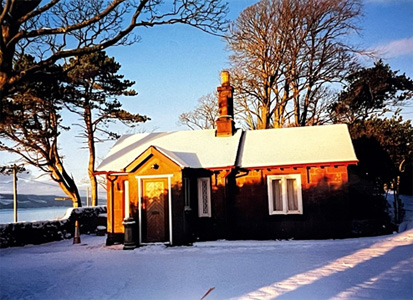
South Lodge in the snow. Source: Jennifer Yeomans
1975 – 2004 Mr & Mrs R M Yeomans
Richard M Yeomans, the second of four children, was born in Aldershot in 1932, to Richard J Yeomans, a military man and Lillian (Spray) Yeomans. When Richard was three and his younger siblings still babies, their father was posted to Egypt and the whole family went with him to a base just outside of Cairo at Abbassia. Five years later, under the threat of the advancing German army, the family moved to South Africa where they lived until the end of the war.[38]
In 1945, the Yeomans returned to their native Cornwall, where Richard (Jnr) completed his schooling before securing an apprenticeship at Hayle Power station. This was the start of a life-long career in the power generation sector with advancements every couple of years as he qualified as an engineer and after further years of study became a fellow of the institute of both mechanical and electrical engineers.[38]
Jennifer Pert was born in Grappenhall, Cheshire in 1935 to Hugh W and Jean (Meek) Pert. At the age of five, Jennifer, her sisters and mother were evacuated to Colwyn Bay to live with her grandmother. The family stayed on in Wales, following the war and after school and secretarial college, Jennifer went to work at Portishead Power station for Sir William Halcrow and partners where she met and married Richard. [38]
Over the next 20 years, the couple had four children – three boys (Mark (1959), Hugh (1963), another and one girl – Nicola (1964). The family were always on the move, as Richard’s career progressed, firstly around the south of England and then to Scotland in 1967, ending up in Largs in 1973 when Richard was appointed deputy Manager of Inverkip Power Station. [38]
![Photos: 1. J Pearson visiting 2. A large expanse of grass to cut 3. Family visiting [39]](https://www.skelmorlievillas.co.uk/wp-content/uploads/2022/09/ashcraig-yeomans-lawns.jpg)
Photos: 1. J Pearson visiting 2. A large expanse of grass to cut 3. Family visiting [39]
For the children, Ashcraig was every bit the fantastic playground that Jennifer and Richard had hoped, each having different memories of building treehouses and dens in the rhododendrons, hanging, and playing on swing ropes, sliding down the garlic covered cliffside on carboard boxes, crossing the road to swim off the jetty, exploring the dry moat with its multitude of colourful spiders – daring each other to see who would go furthest. [39]
Along with the play, there was lots of hard work; land drains to clear, weeds and nettles to pull, the water supply levels to check, shrubs to prune, fallen trees to clear, fire wood to chop, fruit to pick, grass to mow, leaves to sweep, paths and bridges to maintain. [39]
The projects were not just in the garden, over the years, the house was redecorated from top to bottom, Richard and the children doing the painting and wallpapering (great lessons for later life) and Jennifer attending house and antiques sales to acquire furniture for all the rooms and going to night-school to learn how to make lampshades and re-upholster chairs. [39]
In the early 80’s the family embarked on a project to transform what was called the East wing, comprising the stables, the three rooms above, a bathroom and the old laundry, to ‘The Coach House’ for Jennifer’s mother and stepfather. [39]
Author’s Note: The equipment from the old laundry including the sinks, a mangle, washboards, pots for heating the water and a stove, were carefully removed, and donated to an Edinburgh Museum [39]
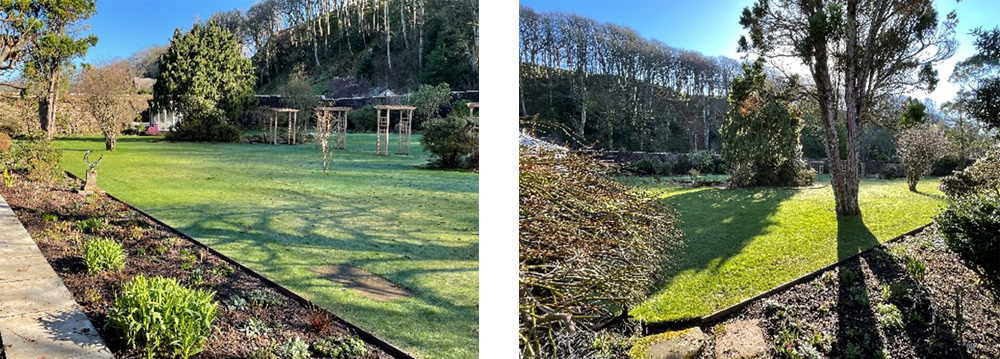
Photo 1: Wall garden looking north-east Feb 22. Photo 2: Wall garden looking south-east Feb 22
Around this time, Richard and Jennifer took the opportunity to buy the wall garden, woodland and byre site from the then owners of North Lodge, incorporating the 3 acres back into the estate. A few years later they also purchased the roadside field, to the south of Ashcraig and north of Auchengarth. [39]
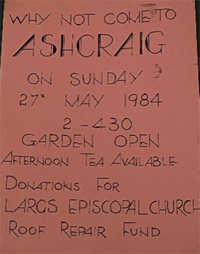
Ashcraig Garden Open in 1984
Over the years, Jennifer maintained and developed the gardens with the help of Richard and to an extent, the children. There was no gardener in the early days, just the occasional help to do the heavy digging, but Jennifer had boundless energy and would often be up at the crack of dawn in the garden, coming in to make breakfast for the family and going back out as soon as the housework for the day was complete. [39]
The garden was opened to the public in 1984, for the benefit of Largs Episcopal Church roof repair fund and twice under Scotland’s Open Garden Scheme once in 1994 and again in 1996. So impressive was the garden at the time, that it even featured on Scotland’s Beechgrove Garden (see above). [39]
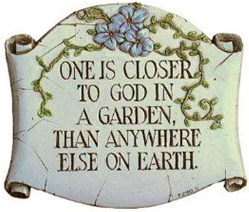
One is closer to God in a garden than anywhere else on earth
As well as the managing the garden, Jennifer set-up her own business in the late 1990s, Ashcraig foliage, which supplied Eucalyptus and other greenery to the Glasgow flower market on a weekly basis. She was very interested in local history, not only collecting much of the material in this history but was also president of Largs Historical Society for a good number of years. She also enjoyed tennis and was playing with her friends on court well into her 70’s. [39]
Whilst at Ashcraig, Richard, continued to climb the corporate ladder, becoming Station Manager at Hunterston and then Chief Operating Officer of Scottish Nuclear and ultimately CEO, before retiring. Outside of work and the garden, he was heavily involved in Largs Rotary, was Secretary of the Largs Episcopal Church for many years and had a love of sailing, owning a part share in a UFO 34. [39]
Richard and Jennifer lived at Ashcraig for 30 years until they decided to downsize. Unable to leave the garden, they built a new home on the site of the old byre, retaining the strip of land from beach to the top of the cliff which included the wall garden and selling the main house, the south lodge and the bulk of the estate in 2004. [39]
Richard and Jennifer lived in their new home, Garden Cottage and lovingly maintained what was and continues to be known as the ‘Secret Garden’ until their respective deaths in 2010 and 2018. [39]
Today Garden Cottage and the wall garden is owned by the two eldest children Mark and Hugh who are following in their parents’ footsteps maintaining and developing the gardens.
2004 – Present: Current Owners
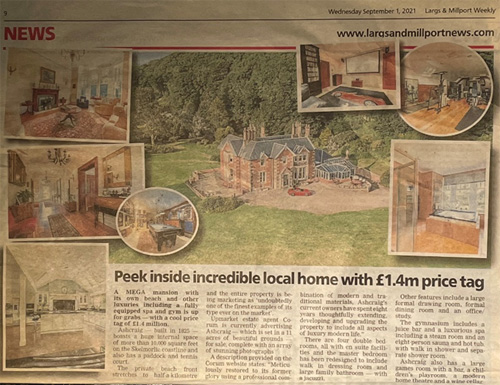 In 2004, the new owners of Ashcraig embarked on making the house their own. This involved the conversion of the former coach house into a gymnasium and spa with sauna, hot tubs, shower room and juice bar. In the basement, they created a games room, playroom, home theatre and in what was a courtyard, added garage space for multiple cars. [37][40]
In 2004, the new owners of Ashcraig embarked on making the house their own. This involved the conversion of the former coach house into a gymnasium and spa with sauna, hot tubs, shower room and juice bar. In the basement, they created a games room, playroom, home theatre and in what was a courtyard, added garage space for multiple cars. [37][40]
The house was extended to the east above the new garage, forming a sizeable open-plan kitchen, dining, and family area which joined with the conservatory. [37][40]
The layout of the formal dining room, drawing room and office were largely unaltered. Upstairs, one bedroom was sacrificed to leave the 4 remaining as ensuite. The Master bedroom was moved to the west of the house and a dressing room added. [37][40]
In September 2021, Ashcraig was put up for sale with a price tag of £1.4m. As of today, end of Sept 22, the house is still on the market. [37][40]
Over its nearly 200 year history, the house has only had 8 owners, the majority of whom lived there for more than 20 years. It will be interesting to see what the next owners decide to do with both the house and grounds.
Additional Items of Interest
Ashcraig Fossil
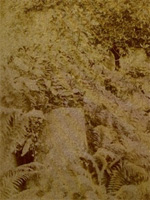
Photo of Ashcraig fossil taken in 1891 by Lt Col. E D Kennedy.
Over the years reference has been made to the Ashcraig fossil. We believe this is an ash tree that has solidified into stone, which was brought to Ashcraig from near Houston where A D Campbell’s brother or brother-in-law lived. Over the last 50 years, many searches have been made particularly around the foot of the waterfall area where it was reported to be, but it’s never been relocated. [20]
Canon in Meigle Bay
During the 1980s following a particularly bad storm, many locals will recall that the top of the barrel and wheels of a small cannon were exposed in Meigle Bay, not far from the end of Ashcraig jetty. [39]
The belief is that that it was most likely a starting gun off one of the yachts previously anchored in the bay, rather than from some long-forgotten war. [39]
Like many, the Yeomans children came up with a plan to recover the cannon which was well embedded in the sand and only visible and accessible at a low spring tide. This involved attaching multiple large floats to the object and then waiting for the tide to come in and force it out of the sand. [39]
They never did get round to it and as it was only on view once a month, it was probably 5 years before they noticed it had gone. Presumably, someone more action oriented had a similar idea. [39]
Sources/References:
[1] Title Deeds for Ashcraig dating back to 1823.
[2] Scottish Archive Network (SCAN) – Weights and Measures Guide & Wikipedia.
[3] Mrs J M Yeomans’s, research notes into Ashcraig’s history and ownership & memories of the author.
[4] www.glasgownecropolis.org/wp-content/uploads/2019/01/Grave-Matter-5.pdf
[5] Mr James Brennan, notes and research on A D Campbell
[6] www.geni.com/people/Robert-Muirheid-of-Croyleckie/6000000026558077560
[7] www.clanmacfarlanegenealogy.info/genealogy- Colonel James Dunlop
[8] Will of Janet Maria Dunlop or Campbell
[9] History of Househill, Glasgowwestaddress.co.uk.
[10] 1841 and 1851 census covering Ashcraig
[11] www.ucl.ac.uk/lbs/person/view/15197 – Legacies of British Slave Owners – A D Campbell
[12] Wikipedia – Slavery_Abolition_Act_1833 & Wikipedia – Glasgow, Paisley_and_Greenock_Railway
[13] Railway Liverpool Standard and General Commercial Advertiser 28/12/1838.
[14] ‘Skelmorlie’ by Walter Smart, 1968
[15] Death certificates for Misses Helen and Margaret Stewart
[16] The Story of the Old West Kirk of Greenock 1591 -1898 by Ninian Hill
[17] www.inverclyde.gov.uk/assets/attach/5115/Intimations-1826-1850.pdf
[18] An 1879 Guide to Wemyss Bay, Skelmorlie, Inverkip, Largs & Surrounding Districts, Rev. John Boyd M.A.
[19] Extracts from Largs and Millport weekly news 1877 – 1885
[20] Letter and photos from correspondence between Mr William Kennedy (great grandnephew of the Misses Stewart) and Mrs J M Yeomans
[21] Disposition by William George Stewart in favour of the Trustees of the late Miss Margaret Stewart and the disposition of the Trustees of the late Miss Margaret Stewart in favour of Colonel Edward Douglas Kennedy.
[22] Disposition by Colonel Edward Kennedy in favour of Robert Drummond French 1918 of Ashcraig Skelmorlie.
[23] Marriage and death certificates for Mr & Mrs R D French
[24] www.glasgowwestaddress.co.uk
[25] Information from Mrs Ganley –housekeeper at Ashcraig during the Allan’s time
[26] Wikepedia – The Allan Line
[27] Biography of James Allan, amongst Mrs J Yeomans’s papers. Possibly extracted from a book by Appleton, called “Ravenscraig”- a history of the Allan family.
[28] Birth, Death and Marriage Certificates for Richard and Agnes Allan.
[29] 1841- 1911 Censuses
[30] Stories related to Mrs J Yeomans by Mr Robert Murdock, RGA’s nephew, who lived at Mansfield, Wemyss Bay until 1993 and Mrs Ganley, housekeeper to the Allan’s.
[31] 1952 Sales Brochure for Ashcraig – Jackson-Stops & Staff
[32] wc.rootsweb.com/trees/616047/I000001/iangarnet-maclaren/individual
[33] https://ancestorium.com.tng/ Ian Garnet MacLaren & Annette Mary Birstwistle
[34] Ian Maclaren, The Glasgow Herald, 6th March 1997.
[35] www.douglashistory.co.uk / Maclaren
[36] The Maclaren family’s stories and recollections
[37] corumproperty.co.uk/property/ashcraig-shore-road-skelmorlie-pa17-5hb
[37] Correspondence between Mrs J M Yeomans and Mrs M Deyes, London re Alexander MacKenzie Mrs Deyes’s great grandfather and gardener at Ashcraig circa 1861 – 1867 and Robert MacKenzie, Mrs Deyes’s, grandfather) born at Ashcraig Cottage, November 1863.
[38] Richard & Jennifer’s family history, courtesy of Mark, Hugh and Nicola Yeomans
[39] Memories of the now not so young Yeomans children.
[40] Peek inside incredible local home, Largs & Millport, Sept 1, 2021.

